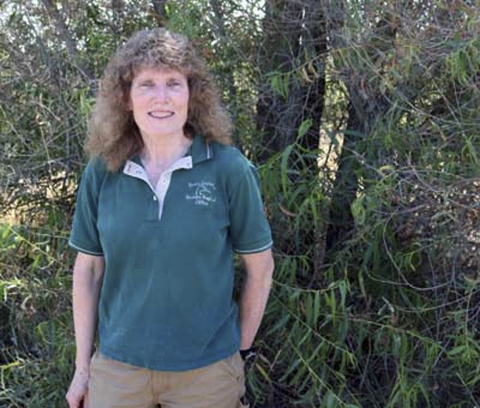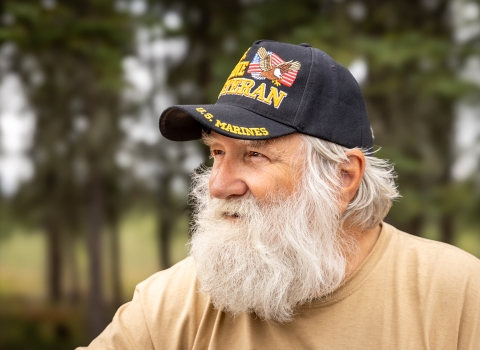The rice fields are his home away from home.
Don Bransford, a third-generation rice farmer in Colusa, California, has been growing the grain since 1980.
His 1,200-acre farm is in the Sacramento Valley, which on the whole supplies the country with nearly all of its sushi rice. Each spring, the farmer levels his fields, adds five inches of water, and, by plane, plants soaked rice seed from the air. He maintains the water level until the grain is ready to harvest in the fall.
The rice isn’t the only thing out there. Over 200 types of birds, mammals, amphibians and reptiles have been documented to use rice fields.
“It would be a very stark morning if there wasn’t any wildlife around,” Bransford said.
Rice farmers manage 500,000 acres in the Sacramento Valley. Another 75,000 acres are managed wetlands, including nearly 18,700 acres of the Sacramento National Wildlife Refuge Complex and 31,000 acres of conservation easements primarily on land owned by duck hunters. Together, the rice farmers, the U.S. Fish and Wildlife Service (Service) and the duck hunters, provide year-round food and habitat for 6 million waterfowl and hundreds of thousands of other water birds and wetland wildlife.
“I’m proud of our close relationship with the Service,” Bransford said. “We try to coordinate efforts to flood rice fields and refuge wetlands to maximize every drop of water for wildlife.”
Flooded fields for food
Craig Isola, deputy project leader for the refuge, has watched the relationship evolve over 20 years with the Service.
“We have great rapport with the rice industry and duck hunters,” he said.
“It has been a very good relationship working with the private duck hunters,” Isola said. “So many of them are willing to put time and money into wildlife habitat. It is really gratifying to work with them to restore and protect the last remaining wetlands in the valley.”
The farmers support the wildlife, too, he said. “We in turn are supportive of their needs for agriculture and acknowledge how important they are to support migratory birds in the Pacific Flyway.”
In Bransford’s fields, black-necked stilts, avocets and mallards raise their young. To help them, he creates higher ground above the flooded fields for nesting and mows the field edges only after they nest. In the fall, after harvest, Bransford floods his fields again for migrating and wintering birds.
Since the 1990s, the Service and other partners have advised rice farmers on these practices that benefit wildlife. Instead of burning the straw, rice farmers now flood up to 350,000 acres to decompose the straw over fall and winter.
The birds love the waste grain, said Jacob Byers, Partners for Fish and Wildlife biologist. It’s critical for winter survival.
“Without this one key element, the whole system could come crashing down,” Byers said.
The sentiment is echoed by Paul Buttner from the California Rice Commission. Without the rice fields, one would have to create 255,000 acres of wetlands at a cost of $2.8 billion and an additional $40-50 million operating cost to maintain, Buttner said.
“We are happy to support the Sacramento National Wildlife Refuge and improve habitat for birds,” said Buttner, who is also the executive director of the California Ricelands Waterbird Foundation. “We recognize that our rice fields are an important buffer around the refuge and add to a larger wildlife-friendly landscape. We help provide world-class habitat.
“It is an awesome win-win situation.”
It would be impossible to maintain the migratory bird populations on public lands only, noted Michael Derrico, supervisory wildlife biologist with the Service.
“Collectively the partnerships are what support the migrating and wintering birds,” he said. “Each cog in the wheel is important for the waterfowl. Mutual goals lead to high-quality waterfowl viewing and hunting opportunities.”
Habitat for the hunt
That other cog is the private duck-hunting community. With the assistance of the Service and Ducks Unlimited, hunters create “better habitat, which leads to better hunting,” Byers said. They also benefit from the rice fields that encourage more birds to stay in the area.
The 31,000 acres of habitat have been protected and improved through the Service Conservation Easement Program. The agency makes a one-time payment to landowners to protect private wetlands in perpetuity through conservation easements. About 95 percent of the wetlands across 150 easements are owned by duck hunters. The refuge then assists the landowners with improving habitat for migratory birds.
One of those landowners is the Senator Duck Club in the Willow Creek-Lurline Wildlife Management Area. The Service and Ducks Unlimited upgraded the habitat by reconfiguring their wetland and water delivery system.
“Prior to the U.S. Fish and Wildlife Service helping us, we had a terrible problem filling the pond,” said co-owner Roy Preston.
“Now we fill within two days, the habitat is in great shape, and everything is using the pond now — river otters, deer, turkeys and doves, whereas before it was pretty much a desert.
“If anyone has the opportunity to work with the U.S. Fish and Wildlife Service or Ducks Unlimited, I’d highly recommend it.”
Ducks Unlimited and the Service provide engineering and biological expertise to get the most “bang for the buck,” as Preston described it.
Requests for assistance are flowing in to Ducks Unlimited from other Willow Creek landowners.
“It takes a landowner who is bold enough to implement restoration projects,” said Virginia Getz, manager for the conservation programs with Ducks Unlimited. “It is scary at first having to turn your duck club upside down and then build it back up. That part is intimidating. We are finding more and more people receptive to it – asking when we will get to their area.”
The Senator Duck Club took the plunge and has not regretted it.
“We have a larger number of birds now and improved goose shooting,” said Eric Iseman, who co-owns the club with Preston. “We need less water now to flood. Before the habitat improvement project, we could not use one third of our land for hunting. Now it is 100 percent accessible and productive.”
The fact is, the water is a limited resource that both the hunters and the farmers need, Iseman said.
“We co-exist so much better with the rice farmers now,” Iseman said. “It is more like one big happy family now, instead of the duck guys versus the rice guys vying for the same limited water resource. If you don’t learn what the problems are, what’s important to each group, you cannot make it work.”
For Bransford, the rice farmer, both the water and the wildlife are important.
“I just feel it’s part of my responsibility as a farmer that I enhance that habitat for wildlife,” he said. “We can coexist... I want to do all I can to see them thrive.”
The U.S. Fish and Wildlife Service supported this Nature’s Good Neighbor through our National Wildlife Refuge System, a network of lands benefiting wildlife and providing unparalleled outdoor experiences for all Americans, and our Partners for Fish and Wildlife Program, a voluntary initiative that works with private landowners to improve fish and wildlife habitat on their land. A phone call or email is all it takes to learn more with one of our 250 private lands biologists. If you are interested in improving habitat for fish and wildlife on your land, please find your local Partners for Fish and Wildlife biologist.













